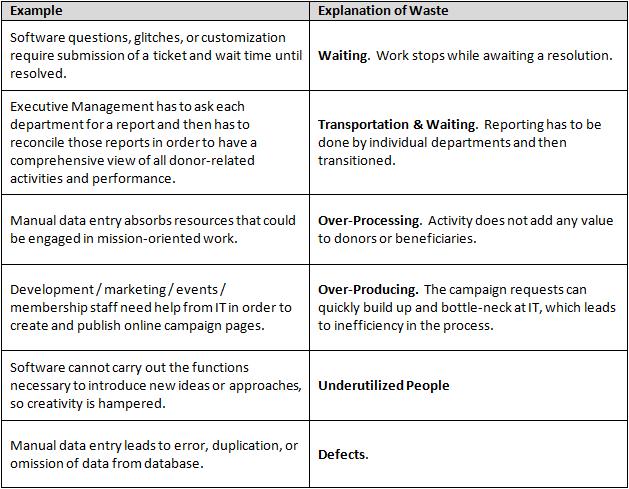
How the right software can help you down the path to a leaner nonprofit organization
More and more constituents are calling for organizational transparency before lending support to a nonprofit organization. In general, they look for confirmation of financial responsibility, organizational efficiency, and proven impact. As nonprofits work to demonstrate that they are trustworthy and effective, it is a perfect time to evaluate internal processes and go LEAN.
LEAN principles were derived from the Toyota Production system in the 1990s. They provide a framework for practice that evaluates workflows to identify various types of “waste” and eliminate them. In this context “waste” is defined as any expenditure of resources that does not bring value to the customer.
The eight types of waste are:
1. Waiting
2. Transportation
3. Over-Processing
4. Inventory
5. Defects
6. Motion
7. Over-Producing
8. Underutilized People
Because these were derived in the context of manufacturing, it may not be immediately apparent how they apply to a nonprofit’s work, and some are more relevant as others. Still, they are a good place to start. Since Big River works with clients that are evaluating donor commerce tools, let’s look at some common examples of waste associated with fundraising/donor commerce software:
As you consider any capital investment, looking at your workflows through a LEAN lens to identify waste is a good exercise. It can help you identify requirements and justify the investment.
Once you’ve adopted software that gives you the means to eliminate much of the waste in your current digital donor commerce workflow and encourages the breakdown of traditional silos, you have a valuable tool to help you employ LEAN methodology as an ongoing part of your organizational management.
Key to good fundraising software’s ongoing support of LEAN methodology is real-time data on the performance of your campaigns and easy access to actionable data. It is this data that will help you evaluate the efficacy of your work and make quick adjustments as needed.
For more on lean methodology as it applies to nonprofit organizations:
Introducing Lean for Nonprofits
Kennard T Wing | February 2010
Is Your Nonprofit Really Ready to Use the Lean Startup?
Ben Morgan | March, 2014
Lean4NGO – online community
To learn more about how Big River supports a LEAN approach, CONTACT US.

